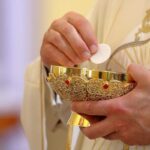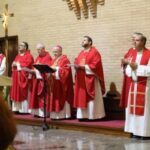We explain what the sacraments of the Catholic Church are and how they are classified. Also, the origin and meaning of each one.

What are the sacraments of the Catholic Church?
In general, a sacrament It is a vow or oath that is taken in order to manifest membership in a cult to an institution or a community. This word comes from the Latin sacramentummade up of the voices sacrum (“sacred”) and –mentum (prefix that means “instrument” or “method”), and was the name given in Ancient Rome to the oath of loyalty and obedience of the Romans to the Roman State and the deities that protected and guarded it.
The term “sacrament” was used in a religious sense when centuries later the letters of the Christian apostles were translated into Latin, in which they referred to their own religious rites with the Greek term mysterion (translatable as “secret”). From then on, Christian rituals also acquired a more militant meaning, that is, an oath of adherence to the Christian faith, and with that same meaning we call them “sacraments” today.
In this way, the sacraments of the Catholic Church are the set of rites of affirmation and confirmation of the Christian faith among its faithful Through them, the faithful express their express and public desire to belong to the community of the faithful and to govern their lives according to what is established in the Catholic creed, that is, according to the Catholic interpretation of the teachings of the ancient prophet Jesus of Nazareth.
These sacraments are carried out officially, with the participation of other faithful and a priest although a few may be administered in the absence of an official spokesperson for the Church.
The way of carrying out the sacraments is governed by ecclesiastical authority and therefore has changed over the centuries. In the different councils and ecclesiastical assemblies the rules that govern them have been debated, discussed and agreed upon, and those in force today date back to the Second Vatican Council, convened by Pope John XXIII in 1959, in order to discuss the role of the Catholic Church in the modern world.
Classification of sacraments
There are seven sacraments of the Catholic Church, organized into three large categories according to the function they fulfill within the community of faithful:
- Sacraments of initiation. They are those who welcome new believers into the Catholic community, or who reaffirm existing believers in their Christian commitment throughout different stages of their lives. There are three rites: baptism, confirmation and the Eucharist.
- Healing Sacraments. They are those that commemorate the healing powers of Jesus of Nazareth through the reconciliation of the troubled or tormented spirit with faith in God. They do not really seek to heal the body or remove ailments, but rather to “heal” the spirit of the faithful through faith. These rites are two: confession, penance or reconciliation, and the anointing of the sick or extreme unction.
- Sacraments at the service of communion. They are those whose purpose is to strengthen the community ties of the parishioner and formally establish, before God and the community of the faithful, certain types of bond between those present. These rites are two: Sacred Orders and Marriage.
The baptism
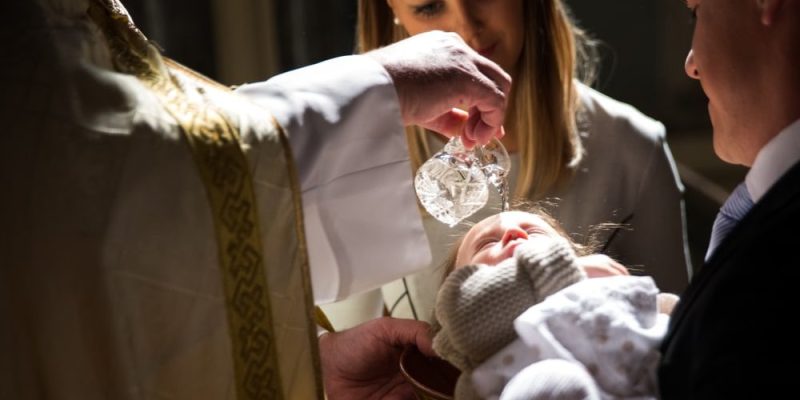
The baptism It is the initial rite of the Catholic faith, which incorporates the baptized into the community of the faithful. Initially it consisted of the immersion of the future Christian in the waters of a river, emulating the similar rite carried out in the Jordan River by John the Baptist, who immersed Jesus of Nazareth himself. This is represented today in Catholic churches through the pouring a little water on the head of the baptized generally in childhood.
The symbolism of baptism alluded to the rebirth of the baptized person into the Christian faith: the unbeliever submerged and perished, and the Christian then emerged from the waters, cleansed of his previous sins (including Original Sin) and ready to join the ranks. of the faithful, waiting for salvation and eternal life. In fact, those baptized in ancient times could assume a new name, a Christian name, to reflect this change.
Baptism, according to the Christian faith, It is forever and cannot be undone, even if the baptized Christian later assumes a different religion. Both children and adults can be baptized, at any time or condition, but in the Catholic parish it is customary to baptize children who have just been born, as a rite to “give” them their name.
The confirmation
Chrism or confirmation of baptism is the next rite in the life of a practicing Catholic, whose purpose is to reaffirm the acceptance of the Christian faith as a model of religious guidance. Through this rite The Christian fully integrates into the parish, carrying out a renewal of the promises of baptism something that happens only once in a lifetime.
The confirmation consists of the laying on of the priest's hands and the subsequent anointing with sacred oils carried out in the church in front of the community of the faithful, normally at an age close to adolescence. The confirmed They are accompanied by a godfather from the same community who plays the role of support in faith and life. Therefore, during the confirmation ceremony, the sponsor must place his right hand on the shoulder of the confirming party.
This sacrament It is administered after religious preparation or education provided by the diocese or local Catholic parish itself, in which the confirmand is educated in different basic aspects of the Catholic faith.
The Eucharist
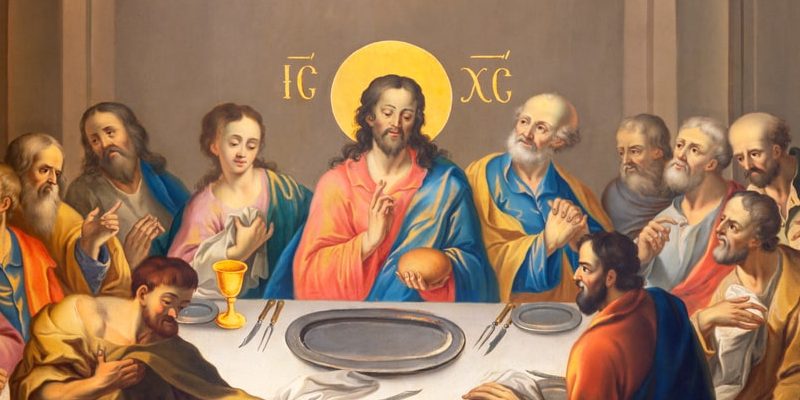
The Eucharist It is the commemoration of the last supper of Jesus Christ, his subsequent passion and his resurrection which constitutes the central episode in the Christian religious story. It is considered the culminating rite of the entry of the new faithful and a rite of reaffirmation of the old faithful, since communion takes place there, that is, the delivery of the sacred host to the faithful, and this can be done as many times in life as you want.
The ritual itself involves a cup of wine from which the priest drinks, proclaiming that it is “the blood of Christ” shed for the forgiveness of the sins of humanity, and then gives the attending faithful a sacred host, such as and how Jesus of Nazareth gave his apostles the bread of the last supper, proclaiming that it was “the body of his body.” Once communion is over, the faithful will have symbolically ingested a portion of the body of Christ and therefore the Messiah will be part of their existence.
The rite of the Eucharist normally takes place as part of the mass, and to receive it the faithful are required to be in a “state of grace” that is, having made confession and having received divine forgiveness for their sins.
Confession, penance and reconciliation
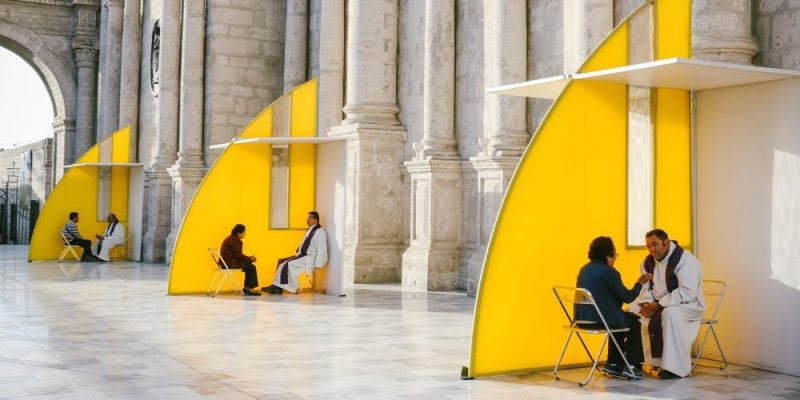
The confession of sins, the assignment of penance and reconciliation with the Catholic faith is a healing rite carried out more or less regularly by the faithful throughout their lives. It is a rite that involves three parts, which develop successively but together, and which Its purpose is to “heal” the souls of the faithful and restore them to the “state of grace.” necessary to, for example, carry out the rites of communion.
This sacrament consists of the admission on the part of the faithful of their sins something that takes place in the privacy of a confessional: a room inside which the priest is hidden from the public eye, while the faithful kneels on the outside and they talk through a window. In this way, the sins committed by the confessor remain strictly private and are protected by the secrecy of confession: no authority can force the priest to reveal what was said.
In response to the confession, The priest then offers words of comfort, guidance and guidance, and assigns a penance corresponding to the magnitude of the sin, in the form of a number of specific prayers (usually the act of repentance). In the end, the penitent is blessed and his sins absolved which is interpreted as his return to the flock of God and his reconciliation with the teachings of Jesus Christ.
The last unction
The anointing of the sick or extreme unction It is a rite performed by the Catholic priest at the bedside of a sick or dying believer as a way to stimulate healing through faith, pray to God for his recovery or, also, for his acceptance in paradise and the salvation of his soul. Originally it was a preparatory rite for death, given only to those who were in a state of agony, but today can be offered to any sick Catholic who wishes to be spiritually comforted.
The rite itself It consists of the joint prayer of priest and sick person, the anointing of the parishioner with sacred oil and sometimes even confession and communion.
The marriage
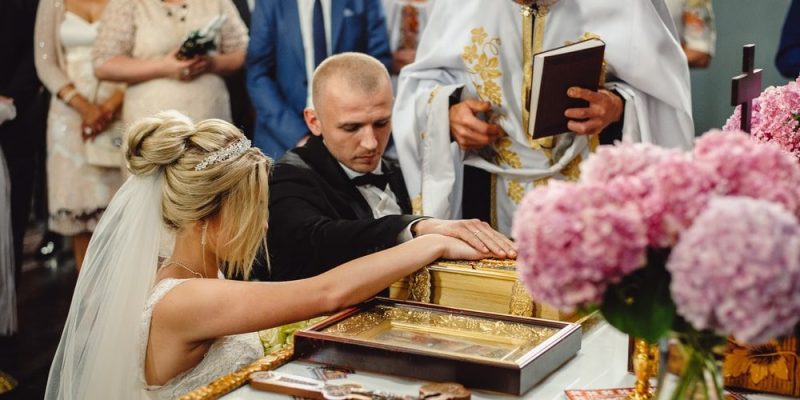
As in the rest of the Christian churches, Catholic marriage is a rite of utmost importance, celebrated to sanctify and make official before the community of the faithful the loving union of a couple of parishioners. This union can only occur between a man and a woman (that is, a heterosexual couple), who have never been married before and who wish to found a new Christian family.
The couple who gets married is thus united before the eyes of God. forever and indissolubly in health and illness, wealth or poverty, and can only be separated by death, since the Church does not recognize the option of divorce.
A particularity of Catholic marriage is that the couple themselves are the ones who recite the vows, in the presence of the priest and their witnesses and companions, so that they are the ones who confer the sacred status on their relationship as a couple.
The vows profess mutual fidelity and responsibility, and precede the giving of the wedding rings and the consummation of the union through a kiss. All of this usually takes place inside a Catholic church, but it can also take place in other places, although always with the presence of the priest.
The sacred or priestly order
The sacrament of priestly orders It is the rite of consecration to the service of God of his ministers that is, of the priests and parish priests of the Catholic Church, who assume a public vow of celibacy and full dedication, and receive in exchange the authority to exercise ecclesiastical functions and conduct formal Catholic rites.
This rite is exclusive for those who receive the call of faith and who pass the selection processes of the ecclesiastical authorities, which implies a long process of religious and theological education.
Continue with: Epiphany
References
- “Sacramento (Catholic Church)” on Wikipedia.
- “What is a sacrament? What are the sacraments of the Church?” in Opus Dei.
- “The celebration of the Christian mystery” on the official portal of the Vatican.
- “Etymology of Sacramento” in the Online Spanish Etymological Dictionary.
- “The Seven Sacraments of the Roman Catholic Church” in The Encyclopaedia Britannica.


